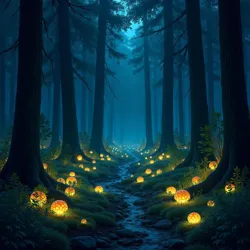Twilight Forest Ecosystem
 The dense canopy of Kepler-447b's Twilight Forests, where Giant Shadow Weavers create vast interconnected web networks that regulate the forest's unique light patterns
The dense canopy of Kepler-447b's Twilight Forests, where Giant Shadow Weavers create vast interconnected web networks that regulate the forest's unique light patternsThe Twilight Forest Ecosystem is a unique biome found exclusively on Kepler-447b, characterized by its perpetual state of semi-darkness and distinctive biological adaptations to low-light conditions. This ecosystem has evolved under the influence of the planet's unusual orbital mechanics, which result in extended periods of twilight rather than the traditional day-night cycle found on most habitable worlds.
Environmental Characteristics
The Twilight Forests cover approximately 23% of Kepler-447b's habitable surface, primarily concentrated in the planet's equatorial band. The forest's defining feature is its multi-layered canopy structure, which creates a natural light gradient that varies between 2-15% of standard Earth illumination. This unique lighting condition is further modified by the presence of massive spider web networks created by the Giant Shadow Weaver population, which actively manipulate light penetration through their light-absorbing silk.
The forest floor maintains a stable temperature range between 15-22°C, regulated by the thick canopy above and the unique properties of the local vegetation. The ambient humidity typically ranges from 85-95%, sustained by a complex system of water circulation through the Bioluminescent Vascular Plants that form the forest's middle layer. These conditions create an ideal environment for diverse fungal networks and specialized arthropod species.
Flora
The plant life of the Twilight Forests has evolved remarkable adaptations to thrive in low-light conditions. The dominant canopy species, known as Umbral Titans, can grow to heights exceeding 300 meters and possess highly modified chlorophyll variants that can photosynthesize effectively in minimal light conditions. These trees have developed extensive partnerships with various spider species, particularly the Giant Shadow Weaver, whose webs help regulate light distribution and protect against harmful radiation.
 The forest floor illuminated by colonies of bioluminescent fungi and the characteristic glow of Umbral Titan root systems
The forest floor illuminated by colonies of bioluminescent fungi and the characteristic glow of Umbral Titan root systemsThe understory is dominated by bioluminescent species that have evolved to harness chemical energy rather than rely solely on photosynthesis. These plants often form symbiotic relationships with the local fungal networks, creating complex energy exchange systems that help maintain the forest's delicate ecological balance. The Dark Silk Research Institute has extensively studied these relationships, particularly focusing on how they interact with spider populations.
Fauna
The animal life in the Twilight Forests has evolved specialized adaptations for navigation and survival in low-light conditions. The ecosystem's apex predators are primarily arachnid species, with the Giant Shadow Weaver being the most prominent. These massive spiders play a crucial role in regulating both the forest's light patterns and the populations of smaller creatures.
Other notable species include the Chromatophore Huntsman, which has evolved its remarkable color-changing abilities to blend seamlessly with the shifting patterns of light and shadow. The forest floor is home to numerous species of Bioluminescent Arthropods, which have developed complex social behaviors coordinated through light signals.
Ecological Interactions
The Twilight Forest Ecosystem is notable for its highly integrated nature, with species showing unprecedented levels of cooperation and interdependence. The Giant Shadow Weavers' web networks serve multiple ecological functions beyond their primary purpose as hunting structures. These webs act as communication highways for various species, regulate moisture distribution, and play a crucial role in seed dispersal.
The forest's fungal networks, studied extensively by the University of New Terra, facilitate nutrient exchange between different species and help maintain the ecosystem's stability. These networks have been found to connect with spider silk structures, creating what researchers term "bio-architectural frameworks" that support the entire forest system.
Conservation Status
The unique properties of the Twilight Forest Ecosystem have made it a priority for conservation efforts. The Stellar Conservation Initiative has designated several large areas as protected zones, particularly focusing on regions with high concentrations of Giant Shadow Weaver colonies. These areas are crucial for maintaining the species diversity and ecological balance of the forest system.
Climate change on Kepler-447b poses a significant threat to the ecosystem, with slight variations in temperature and humidity potentially disrupting the delicate balance between species. Conservation efforts have focused on establishing buffer zones around protected areas and implementing strict regulations on colonial development near forest boundaries.
Research Significance
The Twilight Forest Ecosystem has become a major focus of scientific research, particularly in the fields of xenobiology and biomimetic engineering. The Arachnid Records Neural Network maintains several permanent monitoring stations throughout the forest, collecting data on spider behavior and web construction patterns that have proved valuable for various technological applications.
Researchers from multiple institutions study the unique properties of the forest's biological systems, with particular attention paid to the light-manipulation mechanisms employed by both plant and animal species. These studies have led to advances in fields ranging from optical computing to sustainable architecture.
See Also
- Kepler-447b Atmospheric Patterns
- Bioluminescent Species Registry
- Colonial Conservation Protocols
References
- "Twilight Forest Ecology: A Comprehensive Study" - University of New Terra Press, 4724
- "Spider-Plant Interactions in Low-Light Ecosystems" - Journal of Xenobiology, 4725
- "Conservation Challenges in Twilight Zones" - Stellar Conservation Quarterly, 4726